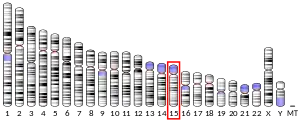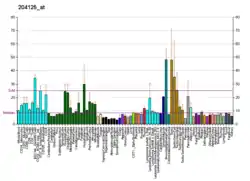NDUFAF1
Complex I intermediate-associated protein 30, mitochondrial (CIA30), or NADH dehydrogenase [ubiquinone] 1 alpha subcomplex assembly factor 1 (NDUFAF1), is a protein that in humans is encoded by the NDUFAF1 or CIA30 gene.[5][6][7][8][9] The NDUFAF1 gene encodes a human homolog of a Neurospora crassa protein involved in the assembly of complex I.[7] The NDUFAF1 protein is an assembly factor of NADH dehydrogenase (ubiquinone) also known as complex I, which is located in the mitochondrial inner membrane and is the largest of the five complexes of the electron transport chain.[10] Variants of the NDUFAF1 gene are associated with hypertrophic cardiomyopathy, leukodystrophy, and cardioencephalomyopathy.[11][12][13]
| NDUFAF1 | |||||||||||||||||||||||||||||||||||||||||||||||||||
|---|---|---|---|---|---|---|---|---|---|---|---|---|---|---|---|---|---|---|---|---|---|---|---|---|---|---|---|---|---|---|---|---|---|---|---|---|---|---|---|---|---|---|---|---|---|---|---|---|---|---|---|
| Identifiers | |||||||||||||||||||||||||||||||||||||||||||||||||||
| Aliases | NDUFAF1, CGI65, CIA30, CGI-65, NADH:ubiquinone oxidoreductase complex assembly factor 1, MC1DN11 | ||||||||||||||||||||||||||||||||||||||||||||||||||
| External IDs | OMIM: 606934 MGI: 1916952 HomoloGene: 32289 GeneCards: NDUFAF1 | ||||||||||||||||||||||||||||||||||||||||||||||||||
| |||||||||||||||||||||||||||||||||||||||||||||||||||
| |||||||||||||||||||||||||||||||||||||||||||||||||||
| |||||||||||||||||||||||||||||||||||||||||||||||||||
| |||||||||||||||||||||||||||||||||||||||||||||||||||
| |||||||||||||||||||||||||||||||||||||||||||||||||||
| Wikidata | |||||||||||||||||||||||||||||||||||||||||||||||||||
| |||||||||||||||||||||||||||||||||||||||||||||||||||
Structure
NDUFAF1 is located on the q arm of chromosome 15 in position 15.1.[7] The NDUFAF1 gene produces a 37.8 kDa protein composed of 327 amino acids.[14][15] NDUFAF1 is associated to complexes of 600 and 700 kDa.[8] Complex I is structured in a bipartite L-shaped configuration, which is made up of a peripheral matrix arm, consisting of flavoproteins and iron-sulfur proteins involved in electron transfer, and a membrane arm, consisting of mtDNA-encoded subunits involved in ubiquinone reduction and proton pumping.[13] NDUFAF1 has been shown to interact with assembly intermediates and may play roles in the correct assembly and combination of the peripheral arm to the complete membrane arm as well as in the stabilization and scaffolding of those intermediates through those close interactions.[8]
Function
NDUFAF1 is an assembly factor that is important for the correct assembly of NADH dehydrogenase (ubiquinone). It ensures the correct combination of complex intermediates and is necessary for the correct functioning of NADH dehydrogenase (ubiquinone). Specifically, NDUFAF1 binds to the large membrane arm intermediate and is involved in the combination of the small and large membrane arm intermediates of complex I. It has also been suggested that NDUFAF1 is involved in the stabilization and scaffolding of assembly intermediates and that this role may be more prominent than its part in intermediate combination.[8]
Clinical Significance
Mutations in NDUFAF1 can result in mitochondrial deficiencies and associated disorders. A disorder of the mitochondrial respiratory chain can cause a wide range of clinical manifestations from lethal neonatal disease to adult-onset neurodegenerative disorders. Phenotypes include macrocephaly with progressive leukodystrophy, non-specific encephalopathy, cardiomyopathy, myopathy, liver disease, Leigh syndrome, Leber hereditary optic neuropathy, and some forms of Parkinson disease.[16]
In a patient with missense mutations in NDUFAF1, fatal infantile hypertrophic cardiomyopathy was diagnosed. In this case, complex I disassembly resulted in a mitochondrial cardiomyopathy with marked lactic acidosis.[11] Another patient, a child with a compound heterozygous mutation (c.278A > G; c.247G > A) within exon 2 in the NDUFAF1 gene, was diagnosed with leukodystrophy associated with mitochondrial complex I deficiency. Signs and symptoms included regression of mental and motor development, white matter lesions, peripheral neuropathy with high muscle tension and hyperreflexia of limbs, and high levels of lactate and creatine kinase. The parents were found to be heterozygous carriers for the mutation.[12] A third patient was found to have a mutation in both alleles of the NDUFAF1 gene and was diagnosed with cardioencephalomyopathy and reduced levels and activity of complex I.[13]
Interactions
In addition to co-complexes, NDUFAF1 has protein-protein interactions with PNLIPRP1,[17] TMEM97,[18] TMEM86B,[19] YIPF6,[20] SLC30A2,[21] ATIC,[22] and MAGEA11.[23]
References
- GRCh38: Ensembl release 89: ENSG00000137806 - Ensembl, May 2017
- GRCm38: Ensembl release 89: ENSMUSG00000027305 - Ensembl, May 2017
- "Human PubMed Reference:". National Center for Biotechnology Information, U.S. National Library of Medicine.
- "Mouse PubMed Reference:". National Center for Biotechnology Information, U.S. National Library of Medicine.
- Janssen R, Smeitink J, Smeets R, van Den Heuvel L (March 2002). "CIA30 complex I assembly factor: a candidate for human complex I deficiency?". Human Genetics. 110 (3): 264–70. doi:10.1007/s00439-001-0673-3. PMID 11935339. S2CID 19502660.
- Lai CH, Chou CY, Ch'ang LY, Liu CS, Lin W (May 2000). "Identification of novel human genes evolutionarily conserved in Caenorhabditis elegans by comparative proteomics". Genome Research. 10 (5): 703–13. doi:10.1101/gr.10.5.703. PMC 310876. PMID 10810093.
- "Entrez Gene: NDUFAF1 NADH dehydrogenase (ubiquinone) 1 alpha subcomplex, assembly factor 1".
- Vogel RO, Janssen RJ, Ugalde C, Grovenstein M, Huijbens RJ, Visch HJ, van den Heuvel LP, Willems PH, Zeviani M, Smeitink JA, Nijtmans LG (October 2005). "Human mitochondrial complex I assembly is mediated by NDUFAF1". The FEBS Journal. 272 (20): 5317–26. doi:10.1111/j.1742-4658.2005.04928.x. PMID 16218961. S2CID 29896047.
- "NDUFAF1 - Complex I intermediate-associated protein 30, mitochondrial precursor - Homo sapiens (Human) - NDUFAF1 gene & protein". www.uniprot.org. Retrieved 2018-07-23.
- Donald., Voet (2013). Fundamentals of biochemistry : life at the molecular level. Voet, Judith G., Pratt, Charlotte W. (Fourth ed.). Hoboken, NJ: Wiley. ISBN 9780470547847. OCLC 738349533.
- Fassone E, Taanman JW, Hargreaves IP, Sebire NJ, Cleary MA, Burch M, Rahman S (October 2011). "Mutations in the mitochondrial complex I assembly factor NDUFAF1 cause fatal infantile hypertrophic cardiomyopathy". Journal of Medical Genetics. 48 (10): 691–7. doi:10.1136/jmedgenet-2011-100340. PMID 21931170. S2CID 35411085.
- Wu L, Peng J, Ma Y, He F, Deng X, Wang G, Lifen Y, Yin F (2016). "Leukodystrophy associated with mitochondrial complex I deficiency due to a novel mutation in the NDUFAF1 gene". Mitochondrial DNA Part A. 27 (2): 1034–7. doi:10.3109/19401736.2014.926543. PMID 24963768. S2CID 207677530.
- Dunning CJ, McKenzie M, Sugiana C, Lazarou M, Silke J, Connelly A, Fletcher JM, Kirby DM, Thorburn DR, Ryan MT (July 2007). "Human CIA30 is involved in the early assembly of mitochondrial complex I and mutations in its gene cause disease". The EMBO Journal. 26 (13): 3227–37. doi:10.1038/sj.emboj.7601748. PMC 1914096. PMID 17557076.
- Zong NC, Li H, Li H, Lam MP, Jimenez RC, Kim CS, Deng N, Kim AK, Choi JH, Zelaya I, Liem D, Meyer D, Odeberg J, Fang C, Lu HJ, Xu T, Weiss J, Duan H, Uhlen M, Yates JR, Apweiler R, Ge J, Hermjakob H, Ping P (October 2013). "Integration of cardiac proteome biology and medicine by a specialized knowledgebase". Circulation Research. 113 (9): 1043–53. doi:10.1161/CIRCRESAHA.113.301151. PMC 4076475. PMID 23965338.
- Yao, Daniel. "Cardiac Organellar Protein Atlas Knowledgebase (COPaKB) —— Protein Information". amino.heartproteome.org. Retrieved 2018-07-23.
- "Mitochondrial complex I deficiency". www.uniprot.org. Retrieved 2018-07-23.
- "pnliprp1-ndufaf1-1". IntAct. Retrieved 2018-07-23.
- "tmem97-ndufaf1-1". IntAct. Retrieved 2018-07-23.
- "tmem86b-ndufaf1-1". IntAct. Retrieved 2018-07-23.
- "yipf6-ndufaf1-1". IntAct. Retrieved 2018-07-23.
- "slc30a2-ndufaf1-1". IntAct. Retrieved 2018-07-23.
- "atic-ndufaf1". IntAct. Retrieved 2018-07-23.
- "magea11-ndufaf1". IntAct. Retrieved 2018-07-23.
Further reading
- Küffner R, Rohr A, Schmiede A, Krüll C, Schulte U (October 1998). "Involvement of two novel chaperones in the assembly of mitochondrial NADH:Ubiquinone oxidoreductase (complex I)". Journal of Molecular Biology. 283 (2): 409–17. doi:10.1006/jmbi.1998.2114. PMID 9769214.
- Rual JF, Venkatesan K, Hao T, Hirozane-Kishikawa T, Dricot A, Li N, Berriz GF, Gibbons FD, Dreze M, Ayivi-Guedehoussou N, Klitgord N, Simon C, Boxem M, Milstein S, Rosenberg J, Goldberg DS, Zhang LV, Wong SL, Franklin G, Li S, Albala JS, Lim J, Fraughton C, Llamosas E, Cevik S, Bex C, Lamesch P, Sikorski RS, Vandenhaute J, Zoghbi HY, Smolyar A, Bosak S, Sequerra R, Doucette-Stamm L, Cusick ME, Hill DE, Roth FP, Vidal M (October 2005). "Towards a proteome-scale map of the human protein-protein interaction network". Nature. 437 (7062): 1173–8. Bibcode:2005Natur.437.1173R. doi:10.1038/nature04209. PMID 16189514. S2CID 4427026.
- Vogel RO, Janssen RJ, van den Brand MA, Dieteren CE, Verkaart S, Koopman WJ, Willems PH, Pluk W, van den Heuvel LP, Smeitink JA, Nijtmans LG (March 2007). "Cytosolic signaling protein Ecsit also localizes to mitochondria where it interacts with chaperone NDUFAF1 and functions in complex I assembly". Genes & Development. 21 (5): 615–24. doi:10.1101/gad.408407. PMC 1820902. PMID 17344420.
- Ewing RM, Chu P, Elisma F, Li H, Taylor P, Climie S, McBroom-Cerajewski L, Robinson MD, O'Connor L, Li M, Taylor R, Dharsee M, Ho Y, Heilbut A, Moore L, Zhang S, Ornatsky O, Bukhman YV, Ethier M, Sheng Y, Vasilescu J, Abu-Farha M, Lambert JP, Duewel HS, Stewart II, Kuehl B, Hogue K, Colwill K, Gladwish K, Muskat B, Kinach R, Adams SL, Moran MF, Morin GB, Topaloglou T, Figeys D (2007). "Large-scale mapping of human protein-protein interactions by mass spectrometry". Molecular Systems Biology. 3 (1): 89. doi:10.1038/msb4100134. PMC 1847948. PMID 17353931. S2CID 670227.
- Vogel RO, van den Brand MA, Rodenburg RJ, van den Heuvel LP, Tsuneoka M, Smeitink JA, Nijtmans LG (June 2007). "Investigation of the complex I assembly chaperones B17.2L and NDUFAF1 in a cohort of CI deficient patients". Molecular Genetics and Metabolism. 91 (2): 176–82. doi:10.1016/j.ymgme.2007.02.007. PMID 17383918.
- Dunning CJ, McKenzie M, Sugiana C, Lazarou M, Silke J, Connelly A, Fletcher JM, Kirby DM, Thorburn DR, Ryan MT (July 2007). "Human CIA30 is involved in the early assembly of mitochondrial complex I and mutations in its gene cause disease". The EMBO Journal. 26 (13): 3227–37. doi:10.1038/sj.emboj.7601748. PMC 1914096. PMID 17557076.
This article incorporates text from the United States National Library of Medicine, which is in the public domain.




